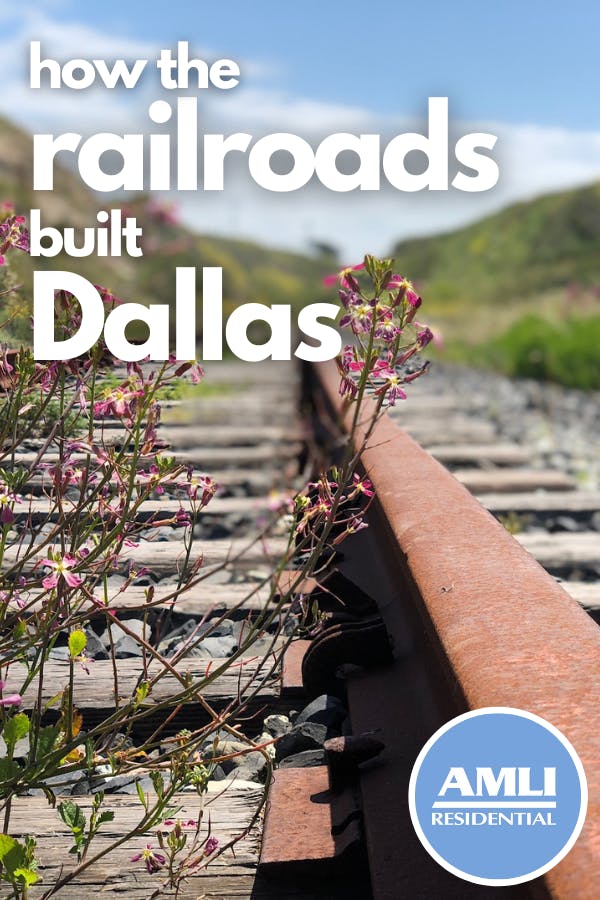What makes for a great new city? Houston had its waterways, Austin had its hunting and Dallas had its… well, fields.
Most cities are founded for their access to natural resources or their proximity to transportation and travel routes. Dallas had neither of those things, yet it became one of the biggest cities in Texas before the 20th century even rolled around.
Why? Because of two railroads that never planned to even go through the city in the first place.
Here’s the story of how Dallas leaders maneuvered two major railway organizations into locating their junction slap-bang in the center of the small, dusty town!
Dallas’ train and railway success story
Dallas back then
The grassy bluffs that made up the area around modern-day Dallas were first surveyed by settlers of European descent back in 1839. John Neely Bryan, a tradesman, lawyer and farmer (a man of many talents!) found the landscape around the forks of the Trinity River to hold great promise, so he stuck a stake in the ground and vowed to return with equipment to establish there permanently.
True to his word, Bryan came back two years later in 1841 and built a settlement right there on the banks of the river. He named the settlement Dallas, though there is no clear reason why he chose the name.
Four years later in 1845, the then-Republic of Texas was annexed by the United States and officially joined the new nation. By then the small settlement had attracted a handful of residents, and the municipality was officially incorporated as a town in February of 1856.
By 1860, the dusty town of Dallas had its very own photography studio and barbershop, and its population had practically soared to a whopping 678. Hardly impressive by today’s standards, of course, but for a rural town in the middle of Nowhere, Texas, it was a fairly rapid growth for the time. Its draw wasn’t trade or transportation, as it was far from any existing railroads or ports, but the great expanses of land provided ample opportunity for ranching. Especially buffalo ranching, which propelled the still-growing town to become the center for the buffalo market in Texas.
Finally, Dallas was officially made a city in 1871, making its mark on not just the map of Texas, but eventually on the nation as a whole.
Early railroads
By this time, there were two major railroads slowly inching over Texas’ landscape. The Houston & Texas Central Railway (H&TC) was moving north from Houston, and the Texas & Pacific Railway (T&P) was slowly approaching from the east from Marshall, Texas to San Diego, California.
Anticipating and predicting significant economic potential from both these railroads, Dallas lawmakers paid the H&TC $5,000 in 1871 to move their railroad 20 miles to the west, passing right into the center of Dallas instead of through Corsicana as originally planned.
The promise of increased traffic and commerce in Dallas as a result of the railroad was a significant draw to investors and businessmen, which increased the population and economy significantly in the next few years.
But Dallas politicians knew they could aim higher. If the east-west T&P intersected the H&TC railway in Dallas, then the city would be firmly established as a major commercial hub in the state. Unfortunately, Dallas wasn’t able to pay T&P to intersect the H&TC in Dallas, so politicians had to devise another way to ensure the redirection and not miss out on the opportunity.
City lawmakers went to the state capitol in Austin and petitioned to have an amendment added to the state legislation on the railroad contracts. This addition stated that the two major railroads were to intersect at a small point called Browder Springs — a fairly simple addendum that seemed perfectly reasonable to T&P, so they went with it without complaint.
It turned out that this “Browder Springs” was oh-so conveniently located just south of Main Street in Dallas, and in 1873 the center of Dallas became the center of two of the biggest railroads in Texas.
A period of rapid growth
Building major railroads and supporting a junction city requires a lot of work and support, so up to the completion of the junction in 1873 the population of Dallas soared. The city went from having 3,000 residents in early 1872 to over 7,000 in September of that year. Traffic and business got so much busier that streetcars and mule-pulled carriages crisscrossed the streets all day long as they ferried businesspeople, workers and residents all over town.
Not long after that, telegraph lines were set up in Dallas, and the once-small town was suddenly connected to the rest of the nation and the rest of the world. The city became a hub for trade and transportation thanks to the trains, with items like grain, cotton, oil, gas, water and travel supplies being loaded and unloaded near-constantly. By the time the 20th century rolled around, Dallas was a booming megacity in the heart of Texas’ endless expanse.
Dallas is still a major railroad city, and its surrounding towns and cities like Grapevine are also heavily steeped in railroad history. The trade and commerce that came as a result of two railroads back in the 19th century are the reason Dallas is as bright, successful and desirable as it is today, and it’s certainly given us good reason to have our luxury Dallas apartments here, too!
So, next time you ride a train or streetcar in Dallas, remember just how much those early trains played a part in the city’s massive growth!
Enjoy!
Pin it!

Featured photo courtesy Pixabay/fancycrave1


 View All Posts by Colleen Ford
View All Posts by Colleen Ford